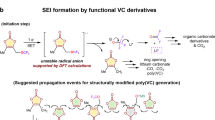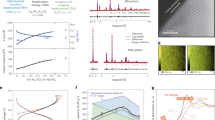Abstract
The applicability of organic battery materials in conventional rocking-chair lithium (Li)-ion cells remains deeply challenged by the lack of Li-containing and air-stable organic positive electrode chemistries. Decades of experimental and theoretical research in the field has resulted in only a few recent examples of Li-reservoir materials, all of which rely on the archetypal conjugated carbonyl redox chemistry. Here we extend the chemical space of organic Li-ion positive electrode materials with a class of conjugated sulfonamides (CSAs) and show that the electron delocalization on the sulfonyl groups endows the resulting CSAs with intrinsic oxidation and hydrolysis resistance when handled in ambient air, and yet display reversible electrochemistry for charge storage. The formal redox potential of the uncovered CSA chemistries spans a wide range between 2.85 V and 3.45 V (versus Li+/Li0), finely tunable through electrostatic or inductive molecular design. This class of organic Li-ion positive electrode materials challenges the realm of the inorganic battery cathode, as this first generation of CSA chemistries already displays gravimetric energy storage metrics comparable to those of the stereotypical LiFePO4.
This is a preview of subscription content, access via your institution
Access options
Access Nature and 54 other Nature Portfolio journals
Get Nature+, our best-value online-access subscription
$29.99 / 30 days
cancel any time
Subscribe to this journal
Receive 12 print issues and online access
$259.00 per year
only $21.58 per issue
Buy this article
- Purchase on Springer Link
- Instant access to full article PDF
Prices may be subject to local taxes which are calculated during checkout






Similar content being viewed by others
Data availability
The datasets generated and analysed during the current study are available from the corresponding author upon reasonable request.
References
Williams, D. L., Byrne, J. J. & Driscoll, J. S. A high energy density lithium/dichloroisocyanuric acid battery system. J. Electrochem. Soc. 116, 2–4 (1969).
Alt, H., Binder, H., Koehling, A. & Sandstede, G. Quinones as rechargeable and regenerable battery cathode and materials. J. Electrochem. Soc. 118, 1950–1953 (1971).
Nigrey, P. J. Lightweight rechargeable storage batteries using polyacetylene, (CH)x as the cathode-active material. J. Electrochem. Soc. 128, 1651–1654 (1981).
Mizushima, K., Jones, P. C., Wiseman, P. J. & Goodenough, J. B. LixCoO2 (0 < x < –1): a new cathode material for batteries of high energy density. Mater. Res. Bull. 15, 783–789 (1980).
Guyomard, D. & Tarascon, J.-M. Rocking-chair or lithium-ion rechargeable lithium batteries. Adv. Mater. 6, 408–412 (1994).
Armand, M. & Tarascon, J. M. Building better batteries. Nature 451, 652–657 (2008).
Poizot, P., Gaubicher, J., Renault, S., Dubois, L., Liang, Y. & Yao, Y. Opportunities and challenges for organic electrodes in electrochemical energy storage. Chem. Rev. 120, 6490–6557 (2020).
Poizot, P. & Dolhem, F. Clean energy new deal for a sustainable world: from non-CO2 generating energy sources to greener electrochemical storage devices. Energy Environ. Sci. 4, 2003–2019 (2011).
Poizot, P. et al. Opportunities and challenges for organic electrodes in electrochemical energy storage. Chem. Rev. 120, 6490–6557 (2020).
Judez, X., Qiao, L., Armand, M. & Zhang, H. Energy density assessment of organic batteries. ACS Appl. Energy Mater. 2, 4008–4015 (2019).
Poizot, P., Dolhem, F. & Gaubicher, J. Progress in all-organic rechargeable batteries using cationic and anionic configurations: toward low-cost and greener storage solutions? Curr. Opin. Electrochem. 9, 70–80 (2018).
Lu, Y. & Chen, J. Prospects of organic electrode materials for practical lithium batteries. Nat. Rev. Chem. 4, 127–142 (2020).
Esser, B. et al. A perspective on organic electrode materials and technologies for next generation batteries. J. Power Sources 482, 228814 (2021).
Lakraychi, A. E. et al. An air-stable lithiated cathode material based on a 1,4-benzenedisulfonate backbone for organic Li-ion batteries. J. Mater. Chem. A 6, 19182–19189 (2018).
Jezowski, P. et al. Safe and recyclable lithium-ion capacitors using sacrificial organic lithium salt. Nat. Mater. 17, 167–173 (2018).
Jouhara, A. et al. Raising the redox potential in carboxyphenolate-based positive organic materials via cation substitution. Nat. Commun. 9, 4401 (2018).
Sieuw, L. et al. Through-space charge modulation overriding substituent effect: rise of the redox potential at 3.35 V in a lithium–phenolate stereoelectronic isomer. Chem. Mater. https://doi.org/10.1021/acs.chemmater.0c02989 (2020).
Foos, J. S. Synthesis and characterization of semiconductive poly-1,4-dimethoxybenzene and its derived polyquinone. J. Electrochem. Soc. 133, 836 (1986).
Oyama, N., Tatsuma, T., Sato, T. & Sotomura, T. Dimercaptan–polyaniline composite electrodes for lithium batteries with high energy density. Nature 373, 598–600 (1995).
Luo, C. et al. Azo compounds as a family of organic electrode materials for alkali-ion batteries. Proc. Natl Acad. Sci. USA 115, 2004–2009 (2018).
Hanyu, Y. & Honma, I. Rechargeable quasi-solid state lithium battery with organic crystalline cathode. Sci. Rep. 2, 453 (2012).
Lux, S. F. et al. LiTFSI stability in water and its possible use in aqueous lithium-ion batteries: pH dependency, electrochemical window and temperature stability. J. Electrochem. Soc. 160, A1694–A1700 (2013).
Armand, M. B., Chabagno, J.-M. & Duclot, M. J. in Fast Ion Transport in Solids, Electrodes and Electrolytes (eds Vashitshta, P., Mundy, J. N. & Shenoy, G. K.) 665–672 (North Holland, 1979).
Thiam, A., Iojoiu, C., Leprêtre, J. C. & Sanchez, J. Y. Lithium salts based on a series of new anilinyl-perfluorosulfonamide salts and their polymer electrolytes. J. Power Sources 364, 138–147 (2017).
Klaus Deuchert, S. H. Multistage organic redox systems—a general structural principle. Angew. Chem. Int. Ed. Engl. 17, 875–958 (1978).
Jimenez, P. et al. Lithium n-doped polyaniline as a high-performance electroactive material for rechargeable batteries. Angew. Chem. Int. Ed. 56, 1553–1556 (2017).
Jouhara, A. et al. Tuning the chemistry of organonitrogen compounds for promoting all-organic anionic rechargeable batteries. Angew. Chem. Int. Ed. 58, 15680–15684 (2019).
Zhu, X. Q. & Wang, C. H. Accurate estimation of the one-electron reduction potentials of various substituted quinones in DMSO and CH3CN. J. Org. Chem. 75, 5037–5047 (2010).
Gottis, S., Barres, A. L., Dolhem, F. & Poizot, P. Voltage gain in lithiated enolate-based organic cathode materials by isomeric effect. ACS Appl. Mater. Interfaces 6, 10870–10876 (2014).
Habibi, D., Pakravan, N. & Nematollahi, D. The green and convergent paired Diels–Alder electro-synthetic reaction of 1,4-hydroquinone with 1,2-bis(bromomethyl)benzene. Electrochem. Commun. 49, 65–69 (2014).
Wang, H. et al. Effect of cycling ion and solvent on the redox chemistry of substituted quinones and solvent-induced breakdown of the correlation between redox potential and electron-withdrawing power of substituents. J. Phys. Chem. C 124, 13609–13617 (2020).
Lakraychi, A. E., Dolhem, F., Djedaïni-Pilard, F. & Becuwe, M. Substituent effect on redox potential of terephthalate-based electrode materials for lithium batteries. Electrochem. Commun. 93, 71–75 (2018).
Doub, L. & Vandenbelt, J. M. The ultraviolet absorption spectra of simple unsaturated compounds. I. Mono- and p-disubstituted benzene derivatives. J. Am. Chem. Soc. 69, 2714–2723 (1947).
Johnson, C. D. The Hammett Equation (Cambridge Univ. Press, 1973).
Peljo, P. & Girault, H. H. Electrochemical potential window of battery electrolytes: the HOMO–LUMO misconception. Energy Environ. Sci. 11, 2306–2309 (2018).
Liang, Y. & Yao, Y. Positioning organic electrode materials in the battery landscape. Joule 2, 1690–1706 (2018).
Genorio, B., Pirnat, K., Cerc-Korosec, R., Dominko, R. & Gaberscek, M. Electroactive organic molecules immobilized onto solid nanoparticles as a cathode material for lithium-ion batteries. Angew. Chem. Int. Ed. 49, 7222–7224 (2010).
Muench, S. et al. Polymer-based organic batteries. Chem. Rev. 116, 9438–9484 (2016).
Bisbey, R. P. & Dichtel, W. R. Covalent organic frameworks as a platform for multidimensional polymerization. ACS Cent. Sci. 3, 533–543 (2017).
Zhao, R., Liang, Z., Zou, R. & Xu, Q. Metal–organic frameworks for batteries. Joule 2, 2235–2259 (2018).
Huskinson, B. et al. A metal-free organic–inorganic aqueous flow battery. Nature 505, 195–198 (2014).
Mourad, E. et al. Biredox ionic liquids with solid-like redox density in the liquid state for high-energy supercapacitors. Nat. Mater. 16, 446–453 (2017).
Acknowledgements
J.W. and X.L. acknowledge the China Scholarship Council for funding. L.S. acknowledges partial support from FSR-UC Louvain for his fellowship. A.V acknowledges funding from a European Research Council (ERC) grant, project 770870-MOOiRE, as well as support from F.R.S.-FNRS through the grants J.0111.16–Equinox, J.0043.18–MESOPOL and U.N011.18–DEMIST. C.M. acknowledges financial support by the MEC, Nucleu-Program, project PN19 35 01 01. J.W. thanks A. Jouhara and E. Deunf for help with the initial experiments.
Author information
Authors and Affiliations
Contributions
J.W., A.E.L. and A.V. conceived the idea and designed the experiments. J.W. executed most of the experimental work, including the synthesis, chemical, spectroscopic and electrochemical studies. A.E.L., X.L. and L.S. complemented the work of J.W. with experiments and studies. C.M. conducted the DFT studies. J.W., A.E.L., C.M., P.P. and A.V. analysed the data and wrote the manuscript. All the authors discussed the experiments, edited the manuscript and gave consent for this publication.
Corresponding author
Ethics declarations
Competing interests
The authors declare no competing interests.
Additional information
Peer review information Nature Materials thanks Kenichi Oyaizu and the other, anonymous, reviewer(s) for their contribution to the peer review of this work.
Publisher’s note Springer Nature remains neutral with regard to jurisdictional claims in published maps and institutional affiliations.
Supplementary information
Supplementary Information
Supplementary Sections 1–17, Tables 1–7 and Figs. 1–49.
Rights and permissions
About this article
Cite this article
Wang, J., Lakraychi, A.E., Liu, X. et al. Conjugated sulfonamides as a class of organic lithium-ion positive electrodes. Nat. Mater. 20, 665–673 (2021). https://doi.org/10.1038/s41563-020-00869-1
Received:
Accepted:
Published:
Issue Date:
DOI: https://doi.org/10.1038/s41563-020-00869-1
This article is cited by
-
Advanced organic electrode materials for aqueous rechargeable batteries
Science China Chemistry (2024)
-
Metal organophosphates: electronic structure tuning from inert materials to universal alkali-metal-ion battery cathodes
Rare Metals (2023)
-
Polyimides as Promising Materials for Lithium-Ion Batteries: A Review
Nano-Micro Letters (2023)
-
Small-molecule organic electrode materials for rechargeable batteries
Science China Chemistry (2023)
-
Organic batteries for a greener rechargeable world
Nature Reviews Materials (2022)



